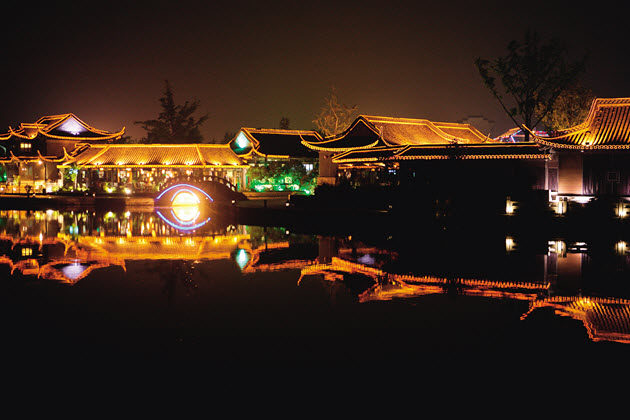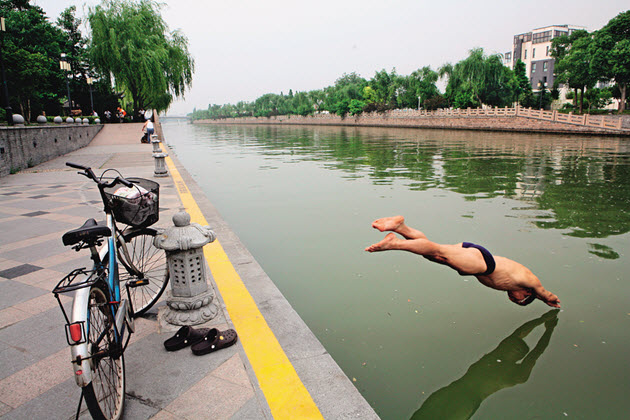Out from the Shadows of History
Yangzhou's Renaissance

Source:CW
Like its many historical landmarks, the ancient city of Yangzhou experienced a century of decline. Yet the city has chosen a path of development that reconciles the traditional and modern, economics and the environment.
Views
Yangzhou's Renaissance
By Hsien-Shen WenFrom CommonWealth Magazine (vol. 453 )
Yangzhou is recorded in history as China's wealthiest city. Japanese author Ryunosuke Akutagawa, an avid reader of Chinese history, was attracted there by its rich lore. Arriving with his head filled with the poetic visions of Li Bo, Du Mu, Ouyang Xiu and Su Dongpo, what he saw upon entering the city from the Grand Canal greatly disappointed him. "Yangzhou's most immediate distinguishing feature is its forlorn, run-down atmosphere," he wrote.
Those words were written in the tumultuous year of 1921. In the subsequent few days, Ryunosuke Akutagawa could hardly take the city's polluted water and foul stench, but whether it was the soft rhythm of the song "Jasmine Flowers," or the natural landscape with "the quiet flow of water over the green hills" as depicted in one of Du Mu's poems, something softened the author's heart to this place, prompting him to write these words in China Travels: "I don't know why, but I always feel as if even the dead are smiling under Yangzhou's muddy ground."
The canal and alleyways Ryunosuke Akutagawa traversed remain today, but proper water treatment has eliminated the forlorn stench, and green corridors stretch out on either side of the river, flowing from the old city to the new town, into the Shouxi Lake and the modern economic development zone. An elderly lady in a white traditional Chinese gown sits alone below the centuries-old vestibule, a quiet and peaceful smile on her face. Standing in contrast to the bustling, boisterous atmospheres of many Chinese cities, Yangzhou is making efforts to find a path of development with enough room for the traditional and modern while reconciling the environment and economy.
Measured Economic Development
The wave of Chinese opening and reform initiated in 1979 failed to ignite an industrial investment frenzy in Yangzhou, allowing the city to avoid serious industrial pollution, demolition and destruction, and preserving the ancient city's leisurely lifestyle.

Even under tight finances, Yangzhou has not neglected to fund the protection of historical sites, even if the budget always seems like a drop in the bucket compared to what is needed to maintain the extensive quantity of artifacts from the Tang, Song, Yuan, Ming and Qing dynasties.
"The mistake we have made in this era is our anxiousness to get things done. Our hearts are in the right place, but the approach is wrong," offers Gu Feng, deputy director of the Yangzhou Municipal Administration of Cultural Heritage and director of the Yangzhou Museum. Although Gu's steadfast stance on protection of cultural artifacts and the historical quarters of the city led to conflicts with the city's mayor and party secretary, the capacity for self-examination is the city's strength, proving its willingness to correct errors.
Outsiders have criticized the Yangzhou populace's care for their forebears' heritage as "narcissistic." In 2004 residents played out a stirring scene on the city's streets. Following the discovery of the city's North Gate, a relic of the Song dynasty, the mayor, acting on a report, visited the scene, only to be surrounded by several hundred locals, who departed only after forcing a promise out of him not to demolish historical sites.
Shouxi Lake is the centerpiece of Yangzhou's garden landscape. In an effort to protect the lake, Yangzhou prohibited the construction of any modern buildings within visual range of the lake. Consequently, builders working on new structures must raise balloons to the same height as that projected for the completed building, and are forbidden from proceeding as long as they are visible from any vantage point along the lake.

Refraining from blind pursuit of GDP figures has actually helped Yangzhou establish the foundation for continued development, as well as a steady stream of awards and kudos, such as UN-Habitat's Habitat Scroll of Honour award, the Chinese Human Habitat Award, National Environmental Protection Model City, Chinese Harmonious Management City, and Notable National Cultural City. A 20-percent rise in visitors annually and tourism revenue of 25.2 billion renminbi amply demonstrate how Yangzhou's attention to quality of life has proven a windfall for the city's service industries and boosted its reputation.
A healthy urban economy requires balanced service and manufacturing industry development. Former Kunshan party secretary Ji Jianye was hand-picked in 2001 by the country's top leadership to oversee Yangzhou on the strength of his success at attracting business.
With Ji at the helm, Yangzhou undertook comprehensive efforts to smooth out the city's transportation, develop new urban districts, widen roads, tear down illegal structures, build new waste and water treatment facilities, and improve water quality in waterways. Under the all-out greening campaign, civil servants were instructed to simplify administrative approval procedures, and to foster a good investment climate for residents.
Forging a Livable Investment Environment
Investments by major Taiwan-based corporations, such as Yadong Cement, YFY, and Living Mall, came about during this period.
With limited space available in the old city, economic development in Yangzhou was targeted at the new East and West Districts on the city's flanks. Just a 20-minute ride by car takes one to the greenery, flowing water, and artificial wetlands that have already lent the new West District the feel of Singapore with its stylish urban planning. And the vast tract of land with the finest vistas in the midst of this area has been given over to Taiwan-based firms to develop and operate.
Having reached a number of agreements, the New Yangzhou City West District poured billions of renminbi into an international exhibition center, museum, large artificial lake, and sports arena. In a display aimed at convincing foreign businesses of the local government's administrative capabilities, work on the international exhibition center was completed in just 99 days, and the artificial lake was dug out and finished in merely two months. For their part, Taiwanese businesses have targeted the high-income class of Yangzhou and neighboring areas, building a multi-purpose shopping and recreation center, Living Mall, and surrounding commercial and residential districts covering over 3,300,000 square meters.
Birth of the World's Largest E-paper Supplier
E Ink Holdings Incorporated of Yangzhou (previously PVI), a subsidiary of Taiwanese paper giant YFY, has grown from a minor investment in 2003 to become the world's largest electronic paper supplier. From Amazon's Kindle to China's own HWDOC-King, 95 percent of the world's e-books use e-paper from E Ink, forming a formidable e-book industrial cluster in China. Yangzhou is expected to lead the way with adoption of e-book technology in junior high schools.
Amazon users may not be aware that Kindle uses the patented technology of a Taiwanese company operating in Yangzhou, yet Yangzhou's determination to be a major player in development of smart grids has already got ink in the pages of the Wall Street Journal.
Smart grids use automated systems to optimize electricity output and modulate power to reduce waste. Chinese premier Wen Jiabao announced in March that smart grid development would be made a component of national policy. The following month, the Smart Grid Demonstration Centre, known colloquially as "Smart Valley," was opened to the public in the Yangzhou Economic and Technological Development Zone.
The center is as large as a sports arena. Former Chinese president Jiang Zemin, a native of Yangzhou trained as an electrical engineer, visited the new facility for two and one-half hours. His picture hangs in a prominent place within the facility, symbolizing Yangzhou's special status in smart grid development. International electronics giants like General Electric and Siemens have established footholds there, and Korea's LG took the biggest exhibition space in an effort to get in on cooperative projects in Yangzhou.
"When Yangzhou began efforts to develop LEDs, the leadership asked if we understood this industry. We didn't know anything about it at the time, but anything can be learned," relates Shi Yixiang, deputy director of the Yangzhou Economic and Technological Development Zone.
Farewell to History's Doldrums
The new Yangzhou has moved beyond history's doldrums for quite some time now, yet the Chinese author Yu Dafu's famous words, "The railroad started running, and Yangzhou sank like a stone," continue to pierce the people's hearts like a sharp awl. China's first railway was originally designed to stretch from Tianjin to Yangzhou, but after extensive deliberation, the Manchu Qing court decided to route it to Shanghai instead.

Yangzhou finally got its own railway in 2004. On May 1, Chinese president Hu Jintao presided over the ceremony marking its maiden journey. With the completion of the Runyang Bridge in 2005, Yangzhou finally realized the age-old dream of spanning the Yangtze River. Over the next decade Yangzhou will get its own airport, metro, and high-speed railway, linking it with the major cities on the Yangtze River delta in a journey of about an hour.
Translated from the Chinese by David Toman






